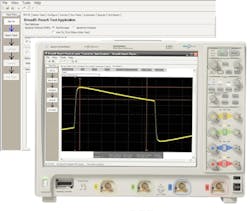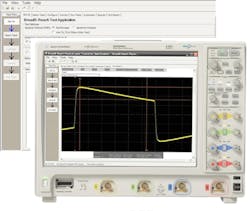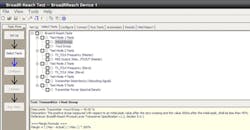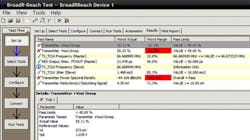Automotive Physical-Layer Compliance Testing
Electronics play a vital and increasing role in meeting world demand for sophisticated vehicles. Insatiable consumer requirements for in-vehicle infotainment, driver assistance, connectivity, and increased device usage have ushered in the need for high-speed serial buses. Then, mix in stringent government regulations, a complex supply chain, and interoperability needs. The result is a fundamental shift in automotive electronics design topologies that incorporate high-speed serial bus backbones with physical-layer (P-L) compliance requirements.
Oscilloscopes play a critical role in P-L compliance testing. For that reason, it’s important to understand the challenges in selecting the right oscilloscope to ensure automotive serial buses adhere to new high-speed standards.
While many other industries can tolerate some degree of design defects, high liability associated with vehicle electronics requires design defects to be minimized and, in many cases, completely eliminated. While most oscilloscope capabilities are industry agnostic, other capabilities have been added primarily for the automotive industry. As an example, for the last decade, scope vendors have offered protocol triggering and decode functionality for automotive buses such as CAN, LIN, and FlexRay. However, none of these buses has had a rigorous specification of P-L compliancy to each specific standard.
Consumer electronics have several standardization bodies, and part of the role they serve is to develop requirements to ensure P-L compliancy and interoperability. PCIe, USB, DDR, and HDMI are examples of multigeneration technologies where standards bodies have helped ensure widespread adoption and compatibility.
BroadR-Reach and MOST150 are new high-speed serial buses in the automotive industry. What makes them unique from a testing perspective is that both have standards bodies that have development tests to determine P-L compliancy. While not new to the consumer industry, these tests are new to the automotive industry and represent a significant inflection in the testing that is required.
BroadR-Reach, also known as Automotive Ethernet, was pioneered by Broadcom for use primarily in automobiles. It was developed with Ethernet compatibility in mind and ended up being very similar to standard Ethernet. In fact, BroadR-Reach supports 10BASE-T, 100BASE-TX, and 100BASE-T standards above layer one of the OSI model.
BroadR-Reach vs. Ethernet
BroadR-Reach looks and feels like standard Ethernet because the termination is the same at 100 Ω, data rates are the same at 100Mb/s, and full duplex communications and the same RJ-45 connector can be used to connect devices. BroadR-Reach supports the OSI model from layer 2-7 (only layer 1, P-L, is different). This means that a host of devices originally used in the Ethernet market can be adopted to run in the car using BroadR-Reach technology. From a developer’s perspective, they can use the same software for standard Ethernet or BroadR-Reach.
The first obvious difference between standard Ethernet and BroadR-Reach is at the P-L with the use of an unshielded single differential pair. This is in contrast to the 100BASE-T standard Ethernet, which uses two differential pairs and typically is shielded. This creates a very significant weight and cost for cabling in the car.
OPEN Alliance publications available on the web state that BroadR-Reach users can achieve a 30% weight reduction and 80% cost reduction compared to standard Ethernet cable. This results in a tremendous saving for suppliers looking for ways to cut manufacturing costs. As well, lower weight contributes to the never-ending goal of fuel-economy increases from the weight reduction of a single pair cable.
There also are signaling differences between standard Ethernet and BroadR-Reach that give the single pair a boost in throughput not recognized in a 10BASE-T standard Ethernet pair.
OPEN Alliance
Since Ethernet was standardized by IEEE, wouldn’t it make sense that BroadR-Reach came from IEEE as well? Not exactly. BroadR-Reach comes from the OPEN Alliance special interest group and was jointly created by Broadcom, NXP Semiconductors N.V., Freescale Semiconductor, and Harman International along with BMW and Hyundai Motor Company. The OPEN acronym is derived from One Pair EtherNet, and the standard body works uniquely in delivering value for the automotive ecosystem.
OPEN Alliance defines a set of standards to determine compliance with the BroadR-Reach P-L standard. P-L testing to a stringent standard is new to the majority of the automotive industry. The compliance testing ensures conformity to the standard and interoperability with other BroadR-Reach technologies. This model has been successful in fostering growth in the consumer industry with standards like USB and PCIe.
OPEN Alliance P-L test specifications rely heavily on an oscilloscope. The type and features of the scope are included in the specification. Testing can incorporate an optional spectrum analyzer for more comprehensive power testing.
Oscilloscope vendors have engineers that translate the P-L test specification into an automated application that runs on a Windows-based scope. Each oscilloscope vendor can choose to fund this investment or not to participate. As an example, Agilent Technologies offers a N6467A BroadR-Reach compliance application that runs on Infiniium oscilloscope families. The application can be purchased with a new scope or added to an existing oscilloscope as a software upgrade.
The BroadR-Reach compliance application runs all of the required tests to verify that the device is working properly, or a user can choose to run a subset of the tests (Figure 1). The results show margins of how close the test passed or failed. Details will indicate the limits of the test, actual values, and the name of the test. Multiple trials as well as different devices can be compared. When appropriate, the application will display a screenshot of the measurement. The report is generated using HTML format so that reports can be shared using Internet Explorer. This makes it easy to document or share testing results because no oscilloscope is required to view the report, as shown in Figure 2.
Oscilloscopes for BroadR-Reach
Here are some oscilloscope capabilities that are required—and others that should be considered—when choosing an oscilloscope for testing BroadR-Reach standards. The scope must run Microsoft Windows because compliance apps do not run on scopes with embedded operating systems. The scope must have a minimum bandwidth specified by the OPEN Alliance P-L tests. Scope vendors that offer BroadR-Reach testing will have this information in the datasheets. A starting configuration will run about $30k. For users that want more testing capabilities, vendors also may offer a spectrum analyzer for power measurements that are more accurate than those that can be made on a scope, a network analyzer solution for users who have an interest in cable testing, and a function/arbitrary waveform generator for users who may have interests in simulating more realistic signals.
Some users want to automate testing so it can be done, for example, over an extended period of time with minimal human interaction. Compliance tests can be run programmatically. Users can run the DUT using many different programming languages including MATLAB, Python, and C#. This added flexibility permits easier testing in an environmental chamber, allows for extended repetitive margin analysis, and enables troubleshooting of elusive issues without having to be in front of the oscilloscope.
Some vendors also provide the capability to add tests not covered in the specification. For example, Agilent offers a user-defined application allowing for additional customization of compliance tests. This application permits users to implement their own tests as add-ons to the formal compliance tests or develop their own automated test outside of BroadR-Reach needs.
Conclusion
As you consider your oscilloscope bandwidth, think about future projects that might require more bandwidth than BroadR-Reach, such as USB, DDR, and HDMI. You can find compliance applications for many of these more popular standards. Each compliance application has the same look and feel, so once you get up to speed on one application, it is easy to learn other compliance applications.
If you are considering incorporating BroadR-Reach in your next-generation automotive design, discuss your upcoming needs with your scope vendor. Find out about what standards are supported and what configuration is needed. The vendor also should be able to perform a quick demo for you or provide loaner equipment for you to evaluate.
About the Authors
Joel Woodward is the senior product manager for oscilloscopes at Agilent Technologies. He joined the company, then Hewlett-Packard, 24 years ago, and his accomplishments include an FPGA debug patent. Woodward received a degree in electronic and computer engineering from Brigham Young University and an M.B.A. from Regis University and completed coursework from Harvard Business School. [email protected]
Alex Bailes is an Ethernet and wireline applications product manager in the oscilloscope division at Agilent Technologies. He has been with Hewlett-Packard/Agilent since 1996 in positions including technical support engineer and network engineer. Bailes graduated with a B.S. in electrical engineering from the University of Colorado. [email protected]



